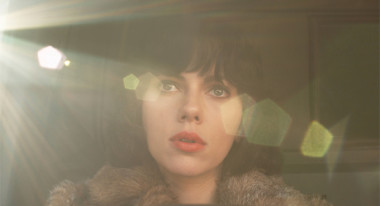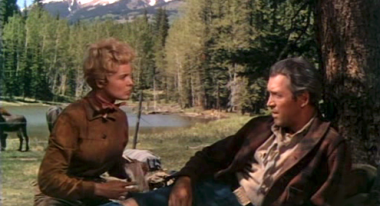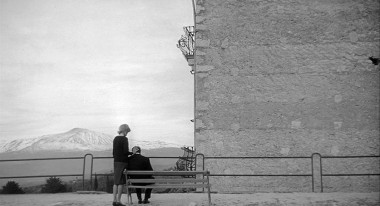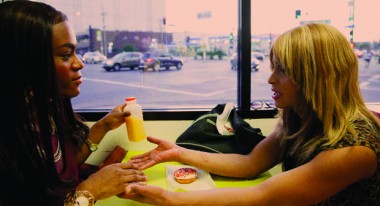 Back to selection
Back to selection
TV is Not the New Film
 Mad Men (Photo: AMC)
Mad Men (Photo: AMC) As much as I love Breaking Bad, The Wire, Mad Men and Twin Peaks, as great and as groundbreaking as those shows were, they still are not cinema.
The recent explosion of quality long-form cable series has taken the TV form to a new level of artistry and craftsmanship. A show like Mad Men is not only thrilling because of its commentary on its era, but because of the zeitgeist energy created by everyone watching the show, talking about it and sharing opinions on social media. Today, perhaps more than ever, a new season of a quality show becomes a cultural event. Combine that with journalism‘s “recap culture,” in which newspapers, magazines and websites devote pages to summaries of the prior night‘s shows — all the while shrinking or even eliminating film reviews — and it’s pretty easy to understand why cinema feels somewhat inadequate in comparison.
Consequently, in all of the excitement over this grand new Golden Age of episodic television, we seem to have forgotten what is unique and singular to the medium of film. Some of us have lost faith in the medium completely and moved on to the search for alternate forms of storytelling, like transmedia. Others have fully embraced the idea that most young people are only comfortable in the short attention span space of Vimeo video clips.
Furthermore, while there used to be a time when unpopular or taboo subjects, settings or perspectives could only be found at the movies, these days there is no subject matter off limits to TV. A positive comedy about an atheist, multiracial, LGBTA, off-the-grid, anarchist free-love family would be no problem these days for any TV network. Back before cable TV, when the advertisers needed to approve the content, it was only in film that taboo subjects and characters could be explored; today, Last Tango in Paris could be pitched as a cable series.
With television co-opting cultural conversation and provocative content, the feature film format is indeed under assault. But, like the novel — which was in free fall in the early ’50s due to the emergence of TV — the form will continue and, in time, a new appreciation of its unique qualities will emerge. If your intent as a creator is primarily to tell stories and engage a mass audience, then I think it has become clear that there are more, possibly better mediums for you than cinema. But if you call yourself a filmmaker or a film lover, then you should be someone invested in the specific qualities of the cinematic medium. In this current time of transition, as new mediums and new lifestyle habits are being formed, we as filmmakers and film lovers need to assert cinema’s position in the crowded visual entertainment landscape.
Quite simply, we need to assert the unique qualities of the feature film format, qualities that make it distinctive from all other mediums. Like an old married couple looking to renew their vows, it may be time for us film lovers to restate the reason why we fell in love with the form to begin with. And if there is no distinction between film and television when it comes to subject matter and characters, then that means the distinction must be found in form, not content. Hopefully, listing these aspects that differentiate film from television will give you a reason to make a film — or to simply go out to your local theater, buy a ticket and enjoy the uninterrupted darkness.
SILENCE.
TV is a dialogue-driven medium. In TV, the writer is king. In series TV, writers work under the guidance of showrunners to create overall series arcs. Individual writers distinguish themselves in the crowded writers room by writing dialogue that soars and leads to a dramatic dynamic between characters that otherwise would not be present. In TV, dialogue is the most important means to communicate plot, theme and character to the viewer.
In cinema, however, images are expected to carry as much as, if not more, significance than dialogue. You can have quiet moments in TV, but extended periods of silence (no music or score — only room tone) is absolutely forbidden. Likewise, using dialogue in an overly ironic or unrealistic manner is also frowned upon in TV. In TV, the meaning is in the words, so you can’t have too much dialogue expressing anything other than the literal rhetorical truth. Characters can lie and be sarcastic, but we must come to realize, through the plot, that they are lying, or are deluded, and that there is an actual literal truth. Could you imagine an ongoing TV series in which everyone speaks as if they were in Pinter’s The Birthday Party or Béla Tarr’s Turin Horse?

Likewise, could you ever imagine silence for more than five minutes without a blasting soundtrack on a TV show? Could you imagine actual plot points happening through images and without dialogue to drive home the point? How about a major turning point signaled only by a sound effect, as in the recent film Under the Skin, when Scarlett Johansson’s character first starts to feel empathy when she hears a baby cry while sitting in a van during a traffic jam? In the theaters, with great 5.1 surround, the sound of the baby crying had a dramatic spatial component. On television, without this spatial positioning, and without the focus an audience brings to a feature film in the theater, this plot point is simply not conveyed as well.
Once dialogue is eliminated as the main means to convey meaning, narrative’s other, purely visual elements become the default transmitter of information. Such elements function in a way that is completely unique to the medium of cinema. When you have little to no dialogue, gestures become the important means of conveying attitude, intent and the inner mood of a character. The eyes of the actor become the literal portals into his or her emotional state. Access to those eyes through the closeup is a powerful cinematic device. TV is primarily a medium-tight format; closeups somehow feel too specific in a TV drama. But in cinema, story space allows for a greater variation in shot size and depth staging. In a story that is being told without a reliance on dialogue, those visual options become extremely significant. In cinema we can spend screen time, sometimes through an extended held shot without a cut, to access the character’s inner state of mind. Getting a sense of a character’s place in the world, without using dialogue, but through the presence of the camera, is what we talk about when we say “cinematic.”

In the new Andrew Bujalski romantic comedy, Results, the main character, played by Kevin Corrigan, barely has any lines of dialogue. Other characters may spew torrents of wellness blather at him, and he remains silent. Yet his eyes, mouth and body posture convey actual truths that clearly reveal his own skepticism, fears, insecurities and anger. It’s a performance that can only be described as cinematic. Could it work in a TV show? Sure, but it’s unlikely that Corrigan’s character would be written in such a way as to place so little emphasis on dialogue to convey his true inner state of mind.
Receiving information and experiencing a character’s journey in a way that depends on visual cues as opposed to verbal ones is the single most distinctive aspect of the cinematic experience.
VARIED MODES OF NARRATION.
TV is primarily told from a third-person, objective point of view. A whole story told from the limited perspective of one character, or even more radically, from a narrator’s perspective — whose point of view may actually be unreliable or not shared by any one actual character — would be way too complicated to be carried through multiple TV episodes. Likewise, the story as a subjective or interior exploration of character, mitigated by the director’s own subjectivity, is primarily the realm of cinema. So too a narrator who does not like his characters, or who has a different world view than the characters, is a function of the more active cinema experience and not commonly seen on TV. (Again, some of the better TV shows occasionally do use a judgmental narrative perspective, like episodes of Outer Limits and The Twilight Zone, in which we feel the narration existing outside of the characters’ perspectives.)
In Mad Men and The Sopranos we feel that the characters’ worldview is flawed, and we are encouraged to engage with the characters through a somewhat critical perspective. But these two recent examples are rare and in many ways part of the reason why they are exemplary examples of the new long-form TV category.

In the films of Max Ophüls, specifically Letter from an Unknown Woman, or more recently in Miguel Gomes’s Tabu, sometimes actual voiceover can be used in a way that still allows for the primacy of image over the word. But only in cinema can the truth be conveyed through a means other than the words. Letter From an Unknown Woman is in many ways an encyclopedia full of examples of the purely cinematic, so many of which could not be used within the TV format. The unique use of voiceover, from an old letter; the use of still photos; the use of unmotivated camera dolly shots — all are in service to this overall theme that the past is alive in the present tense and that the truth is not as it may first appear. This conflation of past into present, done also so brilliantly in Tabu, is part of the experiential aspect of engaging in a story designed to be viewed in one feature format sitting.
CIRCULAR and OBLIQUE PLOTTING.
Could you ever see The Maltese Falcon as a TV series? Audiences would never hang in for plot twists that in the end can’t be followed or don’t add up. If they would, as at least some part of its initial audience seemed to for Twin Peaks, it would be the rare exception. In the case of circular plotting, or what I like to call vortex plotting, the payoff from the primacy of the imagery would not be enough, on television, to offset for audiences the confounding nature of a nonlinear plot. There is no way a TV audience could follow a circular plot like Alfred Hitchcock’s Vertigo or Paul Thomas Anderson’s Inherent Vice over multiple seasons. Yet in the feature film format such strange story formats can be experienced for those viewers courageous and willing enough to be so challenged.
MINIMAL PLOTTING.
TV often sustains interest over multiple episodes through the device of the cliffhanger or dangling plot point. But if your drama has a minimal to flat plot arc, you have nothing to dangle. In order to entice viewers to return at the same time next week, or to binge on through, you need to dangle that plot point. And if you don’t have multiple plot strands, then in TV you must at least have a good amount of reversals. A character who starts off meek has to, after a few episodes, become aggressive and assertive. A female character’s husband has to at some point come out as gay. An aggressive mob boss will in later episodes show his vulnerable fearful side.

You could never have a TV series that lacks both a dangling plot structure and reversals. Yet the style known as slow cinema consists of just such stories containing minimal plots and minimal reversals. Classics of the slow cinema style, such as Lisandro Alonso’s Los Muertos, Kelly Reichardt’s Old Joy, Apichatpong Weerasethakul’s Blissfully Yours, Chantal Akerman’s Jeanne Dielman and such Antonioni films as Red Desert, are all minimally plotted but tell compelling cinematic stories.
Because the rate of reversals needs to be more frequent in TV than in cinema, this means the TV medium is inherently more plot-driven than cinema. Once plot becomes less essential to the story experience we are in true cinematic territory and in a spatial narrative zone that is utterly forbidden to TV.
Films that don’t rely on steep dramatic arcs to sustain interest rely on other components to engage viewers, and those other components become the essential core characteristic building blocks of the cinematic experience. In TV, the script may actually be the blueprint for the final product. In film, the script should be a starting point only; the direction needs to transcend the script in order for it to be called cinema.
A VARIED VISUAL PERSONAL STYLE.
Minimally plotted, ambiguously themed, interior-driven, atmospheric, ponderous, slow silent films with long takes and wide shots may sound like arthouse torture to some people, but those tendencies are only the most obvious examples of cinematic style. A true understanding of what makes cinema different than most TV has to do with an understanding of how the basic components of composition, shot size, camera movement, editing and sound can be manipulated to render a particular director’s visual style. When we speak of the style of directors such as Robert Bresson, Yasujirô Ozu, Roberto Rossellini, Nicholas Ray, Douglas Sirk, Todd Haynes, the Dardennes, Jean-Luc Godard and Andrei Tarkovsky, we talk about their particular use of these basic building blocks of cinematic style. In terms of framing, do they frame in an “open” manner like Renoir or in a “closed” manner like Hitchcock? How do they move the camera or perhaps, as in the case of Roy Andersson, how do they structure their stories around not moving the camera? Do they tend toward staging with deep focus, like Welles, or shallow depth of field like the later Pasolini films? Are they prone to use focus pulls in a self-conscious way, as a way to acknowledge the artifice of the story? What is their tendency in editing?
In general, TV is cut to dialogue, whereas in cinema, the option to cut away from a character who is speaking, or to not even show the person speaking, is the cornerstone of some film directors’ style, along with such self-conscious devices as jump cuts and lap dissolves.
How do film directors use sound to advance their themes? In the case of Robert Altman, he had a tendency to layer multiple conversations on top of one another; this created a certain chaotic energy and an honestly critical attitude toward the construction of story and character intent. In cinema, we don’t talk about style solely in terms of scripts or stories. Whereas in TV, if there is such a thing as an auteur, that person is the writer, not the hired-per-episode directors. When we talk about the specific differences between the Westerns of John Ford, Howard Hawks and Anthony Mann, we talk about those differences in terms of how they handle the articulation of their scripts, not solely in terms of the scripts themselves. The idea that the cinema director is going beyond the script, going under and sometimes around the script, is a tendency that is utterly not part of the TV medium.
Unfortunately we rarely see this these days in American films’ actual direction. Often most American films are just recordings of scripts. But this is cinema’s potential, its ability to lift a story off the page and into a dramatization that is unique compared to all other dramatic mediums. It is the length of the held shots of a character speaking in a Carl Theodor Dreyer film that makes the experience transporting. It’s not only what the character says that is significant; its essential cinematic component is how that dialogue is directed visually.
THE POWER OF THE WIDE SHOT.
TV is primarily a medium tight-shot format. Wide shots tend to lose their power on the small screen, and they tend to release tension.
For this reason it’s harder to maintain an atmospheric tone in TV than in film. This is in part what makes Twin Peaks such a unique TV experience. Lynch managed to find a way to maintain a unique, dark, mysterious mood and tone by working within the medium shot expectations of the format, but in TV that ability is highly unusual.

In cinema, the use of the wide shot often manages to dramatize the location around the character. In the Westerns of Anthony Mann, such as The Naked Spur, the locations become characters in and of themselves. The river and the rocky mountain are forces to be reckoned with as you would a protagonist. In the gritty urban crime dramas of Don Siegel, the hero is often dwarfed by the larger urban landscape around him, which tends to reflect the greater existential dilemma of a cop who cannot solve the crime or achieve true justice.
It is harder to use locations and landscapes in TV due to the smaller format, but also, once more, because the mechanisms driving the drama forward are dialogue and plot. There is less room for the thematic contextualization of the hero’s journey through imagery. Cinematic elements like depth-of-field composition and widescreen framing are usually off limits to TV drama, although recent TV miniseries like Top of the Lake and Olive Kitteridge, both made by primarily cinematic directors, did stretch toward using landscape to capture theme and character.
Because the nature of film drama is primarily a spatial experience, being based around a hero moving through the world, it needs the full palette of cinematic devices to fully manifest itself. This aspect of cinema is somewhat hard to describe because there is no literary term for it. The “presence” of a hero simply existing in a world that is either similar or utterly contrary to our own is by itself compelling. That’s basically the core of the drama in art films by Carlos Reygadas, Lisandro Alonso, Pedro Costa, Béla Tarr and Apichatpong Weerasethakul. The way in which space is articulated throughout the hero’s journey leads the viewer to encounter his or her own existence in a manner like no other medium. There is inherent drama in watching a character make his way through the world. It’s a conflict that draws from the tension between “being” and “appearing” — an inherently physical/visual drama that only cinema can navigate or capitalize upon.
TIME’S PASSAGE AS DRAMA.
Long-form TV drama kicks film’s ass with regards to social-political historical epics that span multiple years. Due to the large amount of viewing hours it is able to marshal, television’s ability to produce awe-inspiring, epic historical tales is unmatchable. But, the feeling of experiencing time expanded, or contracted, within the shorter feature film viewing length (even when extended to seven-and-half hours, as in Béla Tarr’s Satantango) is utterly unique. Only cinema is willing to retard time to the extent that a small amount of plot time is dramatized through real screen-time expansion. Like a musical composition, the time limit of the feature format increases its urgency through compression. Directors who use the urgency of compressed time within the feature film format are in this way closer to musical composers than novelists. The fusion of the two is again one of cinema’s unique qualities
AMBIGUITY.
A major part of what it means to be alive is dealing with uncertainty. None of us really knows what is true, what is coming next and what it all means. Cinema has the ability to grapple with dramatic questions that do not reveal easy answers in an immediate spatial, physical way. The horror films of Val Lewton made frightening our not knowing what is just outside the frame. Letting such questions be the entirety of the dramatic experience is not something that episodic TV does very well.

At the same time, it must be said, most films today rarely are able to navigate these murky waters either. A film like Antonioni’s L’Avventura, in which a friend disappears during a boat excursion, and in which the mystery of her disappearance is not solved nor actually fully investigated, is the type of film that could barely get made today, let alone watched. Often, especially in America, we like our stories to “have a point” and to reach a firm conclusion (read the recent absurd review of Roy Andersson’s latest film in Entertainment Weekly). It’s tough to manage this type of drama in film and even harder within the TV format. Part of the reason the ending of The Sopranos was so bold and unprecedented was because the long-running series ended upon a true note of ambiguity regarding the future destiny of the hero and his family.
ACTIVE VIEWING REQUIRED.
TV still needs to treat the viewer as a passive couch potato. Although this is changing somewhat with shows that push the limits by featuring sympathetic antiheros, the format still is stuck with the notion that the audience can change the channel in a quick moment. Thus, there is less willingness in television to deal with unanswered or misleading dramatic questions. Godard once said that the real drama in cinema happens between the screen and the audience — meaning the audience has to participate in the creation of meaning.
Although it’s a rare aspect of American cinema, the idea that the film demands the viewer participate in the creation of meaning is utterly not an option on television. In the films of Rick Alverson, such as in his recent Entertainment, the audience must actively engage with the events on the screen. Meaning or “truth” is not coded or hidden in metaphor; meaning in his films is found through the audience pushing against the events depicted on the screen. In some ways the experience of watching his films is confrontational. The audience member is threatened and challenged to create meaning. It is not handed to you like it often is in TV. This is also one of the reasons why Bennett Miller’s directorial style is unique — he’s not shoving his perspective on the plot down your throat. His is a subtle, quiet voice that drives the storytelling, and that quiet voice is not sustainable over the length of a long, multiple-year TV series. Foxcatcher treats the viewer with a type of respect that is rare these days. By not forcing its point-of-view, and through its pacing, tone and modulated performances, it allows its view of events to emerge from between the beats of its plot
The ability to tell a story visually, utilizing means other than just dialogue and plot, is the unique potential of cinema. It may be unusual for current American directors to fully exploit this potential, but if we are going to distinguish ourselves from long-form TV series then it is these qualities that we must emphasize and relish.
Over the decades there have been regular proclamations about the death of cinema.
When I was working as a projectionist at New York’s Bleecker Street Cinema in the mid-80s, I was shocked one day to be told by Dan Talbot, founder of New Yorker Films, that most rep theaters were about to go out of business due to an up-and-coming new invention called VHS. By many people’s definition, VHS was the beginning of the end of cinema because it moved the bulk of film viewing from a darkened widescreen theater to the smaller TV in the living room. Cinema has survived that threat, in part because home TVs have gotten bigger, but mostly because, despite the closing of many theaters, the value of cinema does transcend the physicality of the viewing format.
Likewise, when digital cameras became prevalent and film stock started to become rare, many worried that true film was dead due to the digital revolution. This argument never made sense to me because all TV was shot on film stock, so the capture medium itself could not be a criteria of the cinematic.
In the ’90s I worked locations on a TV show called New York Undercover. We shot on 16mm in fantastic, off-beat New York City spots, yet we rarely got to experience those locations in the final cuts because the show was designed for the tight, medium-shot TV format. Film stock still couldn’t help the show to become any more cinematic and rise above the banal scripts and TV direction.

But, despite the almost total elimination of actual celluloid in movies today, the idea of cinema is still vibrant and alluring. Sean Baker’s new iPhone-captured Tangerine is still more cinematic than many films shot on actual film stock. Of course, when you combine cinematic grammar with actual film stock, and those qualities of the film stock inform the story and the spatial experience — as they do so brilliantly in Jeff Preiss’s recent Lowdown — you’ve got a cinematic grand slam.
Film stock and giant theater screens are not to me defining qualities of cinema, and, likewise, I don’t want to indulge in outdated banter about the threat to high culture by the mass medium of TV. Those “fear of obsolescence” arguments have been going on since the first appearance of the printed word, when Socrates feared that the oral tradition would be destroyed by lazy readers, who would rely on the printed page rather than memorization, which in turn would cause slothful habits in young pupils.
I have no fears about cinema’s death, but I do fear that audiences, distributors and film festival programmers have started to forget that cinema is very different than TV. With mediocre TV pilots being programmed into film festivals and bland two-hour de facto pilots masquerading as feature films, I think it’s time we remind ourselves as to why we love film and admit that there is a difference between the two mediums. Let’s celebrate those differences and be aware of what a true film is as opposed to the latest mediocre rom-com trying to split the difference between TV and film. Filmmakers need to stop self censoring themselves, and conservative distributors need to get out of the way of distributors who realize that it is only through bold, distinctive cinematic voices that the medium will regain the respect of audiences of all ages. The new distributor A24 is a voice for the future with their recent release Ex Machina. It’s a real film, and anyone who calls themselves a film lover needs to see it on the big screen while it is still in theaters. Its success demonstrates that there is an audience demand for challenging, true cinema that deploys all of the above described qualities.
Filmmakers, film lovers and film festival programmers must today understand that cinema has become a niche medium, and they must become champions of the art form, constantly asserting the medium’s qualities. Festival programmers must see their job as promoting cinema by programming truly challenging films and banning the showing of TV pilots, as Cannes has done. And filmmakers need to make cinema, not TV pilots in 90-minute form.
Have no fear, TV is not the competition if you are making, programming and distributing actual cinema. Cinema will survive, despite or regardless of how great long-form TV continues to be.
Mike S. Ryan is a film producer who has produced films for Todd Solondz, Kelly Reichardt, Hal Hartley, Rick Alverson and Bela Tarr. His latest films are Free in Deed, by Jake Mahaffy, premiering at the Venice Film Festival, and The Missing Girl, but A.D. Calvo, premiering at the Toronto International Film Festival.
